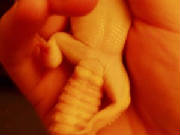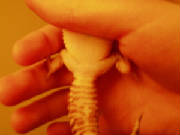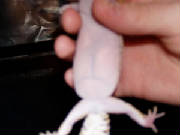|
Place of origin:
The leopard gecko is native to Afghanistan,
northwestern India, and Pakistan.
They live in the rocky desert and savanna regions. Most of the first captive stock was imported from Pakistan. The leopard gecko comes from the reptile family Eublepharidae, this includes
all geckos with moveable eyelids. All geckos in this family also lack toe pads. Because they have no toe pads these lizards
are not able to climb smooth, vertical surfaces. The scientific name of the leopard gecko is Eublepharis macularius.
Housing:
Leopard geckos need a cage suited to their needs. Their cage should be easy to clean and made of a non-porous material.
A ten gallon aquarium can house one leopard gecko. A 20 gallon will hold 2 or 3.
Diet:
In captivity the leopard gecko’s main diet is
mostly crickets, meal worms, lobster roaches, wax worms, and maybe a pinky mouse if the gecko is big enough. You should only
feed fatty food items, like pinky mice and wax worms as a snack or to help a hungry female gain weight after she lays her
eggs. You should gut load the food items for at least 24 hours before you feed your gecko. A few good gut loading items are:
Carrots, Oranges, Bran, Powdered milk and fresh Spinach. The
leopard gecko should also be on a vitamin calcium supplement. A calcium or multi-vitamin containing vitamin d3 should be dusted on crickets or meal worms once a week. The vitamin
D3 helps leopard geckos metabolize calcium.
Heating:
Heating the cage can be done in many different methods.
Over head lights, under tank heaters, and ceramic heat emitters. Leopard geckos need under tank heat to aid in digestion.
In my opinion the best way to heat a leopard gecko enclosure is with the combined use of under tank heaters and overhead lights
on timers. You do not need to use any special lights. Regular incandescent bulbs will do fine. Heat rocks are the worst thing
to use with any reptile. They tend to store too much heat and in some cases they burn the reptiles that use them. Whatever
heating method is used, leopard geckos need a temperature gradient in their enclosure. On the warm side of their cage
the temperature needs to be eighty seven to ninety and on the cool side seventy to eighty.
Substrate:
The flooring of the cage should be something that can
be cleaned or replaced easily. Paper towel and indoor/outdoor carpet work well for flooring. Sand or wood shavings should
be avoided. These types of substrates can be eaten and cause impaction.
Hides:
Leopard
geckos are nocturnal. They need at least two shelters, one for the warm side and one for the cold side. The shelter on the
warm side should be what is called a "humid hide". These can be made out of a Tupperware bowl with a lid. Inside the humid
hide should be some kind of bedding that will hold moisture. Moist sphagnum moss works well. The humid hide aids in shedding,
and the females will most likely choose it to lay their eggs.
| Male Leopard Gecko |

|
| Notice the "V" Shaped row of Pre-anal Pores |
| Female Leopard Gecko |

|
Breeding:
Breeding leopard geckos is a pretty easy process as
long as you are sure you have a male and female. The easiest way to tell the difference between a male and a female leopard
gecko is to take a look at their pre-anal pores. Males have a dark “V” shaped row of pre-anal pores. Females do
not. Leopard geckos have a breeding season that starts about February and ends around September. It may be necessary to pre-condition
your geckos before breeding season. I suggest using lamp timers and gradually increase the amount of daylight from 10 to 14
hours over a few weeks. Females only have to breed once or twice a season because they can store the male’s sperm in
her body form six months to a year. It is a good idea to breed your geckos every few months during the breeding season to
make sure your female has a fresh supply of sperm to fertilize her eggs.
| Female With Eggs |

|
Laying: A
few weeks after their breeding the female will lay her eggs. You should provide a humid hide with moist potting soil in it
for a laying chamber. You can tell when she is about to lay when you see the eggs through the skin on her abdomen. Most females
lay clutches of two eggs. Older or younger females may only lay one egg at a time. It is normal for females to lay one clutch
of eggs every Two to five weeks during the breeding season.
Incubation:
When you find the female has laid you should mark the top of the eggs so you know what side to face up incase they
get knocked over. Then they should be gently taken out of her cage and put in a incubator the same side they were found on
in the cage. The incubator should have moist potting soil or pearlite in the bottom. They take about six to twelve weeks to
hatch depending on what temperature they are incubated at. The incubation temperature also affects the sex and color of the
hatchlings. If you incubate the gecko eggs at seventy nine to eighty three degrees you will have mostly females. If you incubate
from eighty four to eighty six you will get a mix of male and female. At eighty seven to ninety you will get mostly males.
Hatchlings:
When the eggs begin to hatch don't try to help the hatchling out of the egg,
it may take a while before he is completely out. While he is trying to break free of his egg he is also absorbing the yolk
sack in the egg. The hatchling will need this energy supply to last him for a few days before he starts eating. The new hatchling
will start eating after his first shed. I house my hatchlings on paper towels until they are 20 grams.
|

